#HTML elements for web development tutorial
Explore tagged Tumblr posts
Text
Want to upgrade your coding skill to create animations and interactive graphics? This blog covers everything about HTML animation including the Canvas API.
#Basic HTML tagsexplained#Introduction to HTML elements#HTML basics#HTML tutorial#Master HTML#HTML tags#Web development#Learn HTML#HTML for beginners#HTML guide#HTML syntax#Building web pages#Basic HTML elements#Learn HTML elements#Learn Online HTML#Online HTML Tutorial#Introduction to HTML#HTML tutorials#Learn HTML online
0 notes
Text
JavaScript Tutorial: A Beginner's Guide to the World of Web Development
Welcome to the exciting world of JavaScript! If you're looking to dive into web development, understanding JavaScript is essential. This versatile programming language powers the interactive elements of websites and is a key component of modern web applications. In this tutorial, we'll cover the basics of JavaScript, its syntax, and some practical examples to get you started.
What is JavaScript?
JavaScript is a high-level, dynamic, and interpreted programming language that is primarily used for enhancing the interactivity of web pages. It allows developers to create rich user experiences by manipulating HTML and CSS, responding to user events, and communicating with servers.
Why Learn JavaScript?
Ubiquity: JavaScript is supported by all modern web browsers, making it a universal language for web development.
Versatility: Beyond the browser, JavaScript can be used on the server-side (with Node.js), in mobile app development (with frameworks like React Native), and even in game development.
Community and Resources: With a vast community and numerous resources available, learning JavaScript is more accessible than ever.
Getting Started with JavaScript
Setting Up Your Environment
To start coding in JavaScript, you don't need any special software. All you need is a web browser and a text editor. Here’s how to set it up:
Choose a Text Editor: Popular options include Visual Studio Code, Sublime Text, and Atom.
Open Your Browser: You can use any modern browser like Chrome, Firefox, or Edge.
2 notes
·
View notes
Text
HTML Tutorial: A Quick Overview
HTML (HyperText Markup Language) forms the backbone of web development, enabling the structure and presentation of content on the web. It’s a markup language that defines elements like headings, paragraphs, links, images, lists, and more, providing a standardized way to format and display information in browsers.
HTML uses tags, enclosed in angle brackets, to represent different types of content. Each tag typically comes in pairs, an opening tag and a closing tag, to wrap and describe the content in between. HTML is fundamental for building web pages, allowing developers to create structured documents with defined sections and multimedia elements.
One of HTML’s key features is its ability to create links, connecting different parts of the web. This hyperlinking capability is what makes HTML unique, forming the web as we know it today. Additionally, HTML supports embedding multimedia like images, videos, and audio, which brings pages to life.
As web standards evolve, HTML has grown, too, with the latest version being HTML5. This version introduced new elements that provide semantic meaning to the structure of web documents, ensuring that content is more accessible and well-organized.
fro more:https://quipoin.com/tutorial/HTML-tutorial
2 notes
·
View notes
Text
Top 10 Front-End Frameworks and Libraries for 2024
As the web development landscape continues to evolve, staying updated with the latest front-end frameworks and libraries is crucial for any developer. Whether you're a seasoned pro or just starting out, knowing which tools to use can significantly impact your productivity and the quality of your projects. In this post, we’ll explore the top 10 front-end frameworks and libraries that are set to dominate in 2024.
1. React
React remains one of the most popular front-end libraries, known for its simplicity and flexibility.
Key Features of React
Component-Based Architecture: Reusable components make development efficient and manageable.
Virtual DOM: Enhances performance by minimizing direct DOM manipulation.
Strong Community Support: A vast ecosystem of tools, libraries, and tutorials.
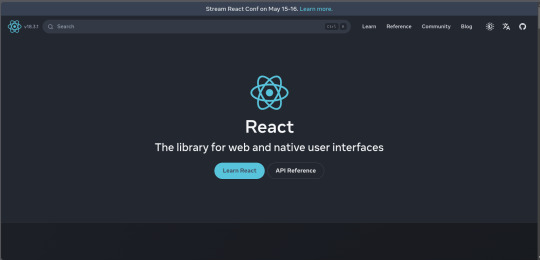
2. Angular
Angular, backed by Google, is a powerful framework for building dynamic single-page applications (SPAs).
Why Choose Angular?
Two-Way Data Binding: Synchronizes data between the model and the view.
Dependency Injection: Improves code maintainability and testability.
Comprehensive Documentation: Extensive resources for learning and troubleshooting.
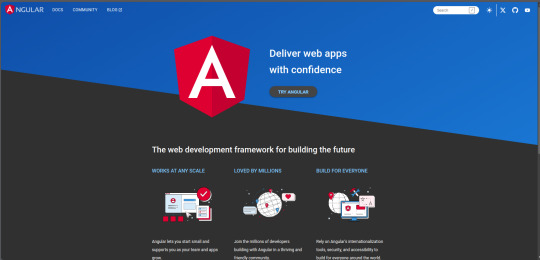
3. Vue.js
Vue.js has gained popularity due to its gentle learning curve and versatility.
Advantages of Vue.js
Reactive Data Binding: Simplifies state management.
Single-File Components: Encapsulate HTML, CSS, and JavaScript in one file.
Flexibility: Can be used for both large-scale and small-scale applications.
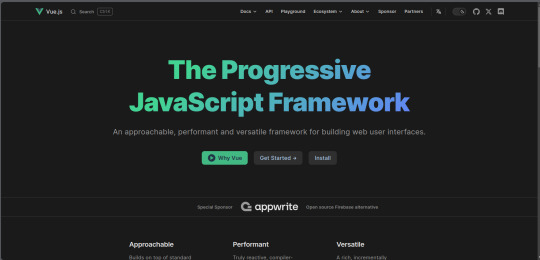
4. Svelte
Svelte is a relatively new player that compiles components into highly efficient vanilla JavaScript at build time.
Svelte’s Standout Features
No Virtual DOM: Directly manipulates the DOM for better performance.
Less Boilerplate: Cleaner code with minimal overhead.
Ease of Use: Intuitive and straightforward syntax.
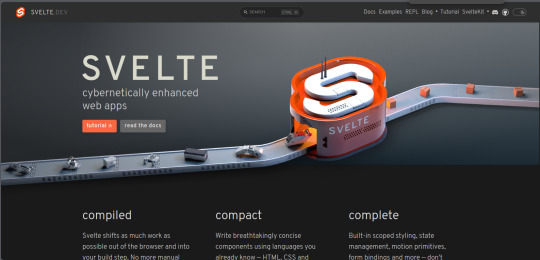
5. Bootstrap
Bootstrap is a front-end framework that provides pre-designed components and a responsive grid system.
Benefits of Using Bootstrap
Responsive Design: Ensures your site looks great on all devices.
Pre-Styled Components: Saves time with ready-to-use UI elements.
Customizable: Easily customize with Sass variables and Bootstrap’s extensive options.
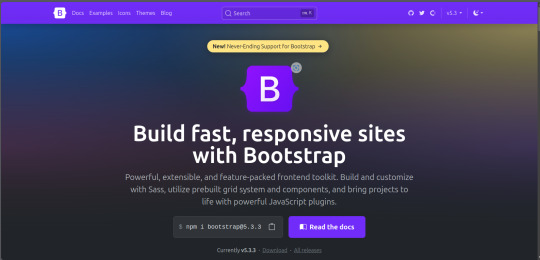
6. Tailwind CSS
Tailwind CSS is a utility-first CSS framework that allows for rapid UI development.
Tailwind CSS Features
Utility-First Approach: Use utility classes directly in your HTML.
Customizable: Extensive configuration options to suit your project’s needs.
Consistency: Enforces a consistent design language across your project.
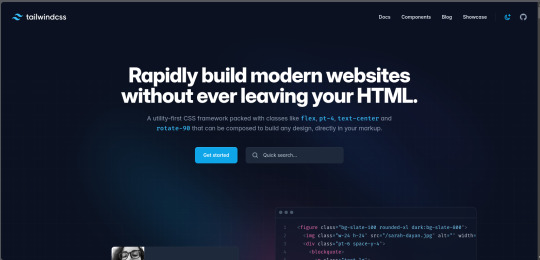
7. Ember.js
Ember.js is a robust framework for building ambitious web applications.
Why Ember.js Stands Out
Convention over Configuration: Reduces the amount of decision-making and boilerplate code.
Strong Routing: Powerful routing capabilities for managing application state.
Productivity: Focuses on developer productivity with built-in best practices.
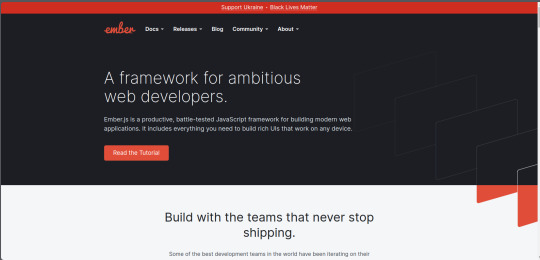
8. Alpine.js
Alpine.js offers a minimal and lightweight way to add interactivity to your websites.
Key Features of Alpine.js
Lightweight: Small footprint with only a few kilobytes.
Declarative Syntax: Similar to Vue.js, making it easy to understand and implement.
Ease of Integration: Can be easily integrated into existing projects.
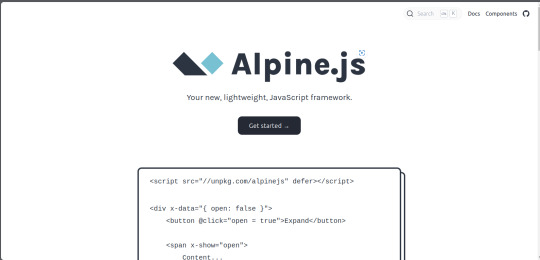
9. Next.js
Next.js is a popular React framework that enables server-side rendering and static site generation.
Benefits of Using Next.js
Server-Side Rendering (SSR): Improves performance and SEO by rendering pages on the server.
Static Site Generation (SSG): Pre-renders pages at build time for fast load times.
API Routes: Allows you to create API endpoints within your application.
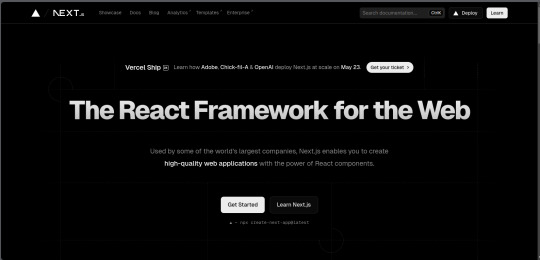
10. Lit
Lit is a simple library for building fast, lightweight web components.
Advantages of Lit
Web Components: Embraces the web components standard for reusable, encapsulated HTML elements.
Performance: Lightweight and highly performant.
Simple API: Easy to learn and use with a minimal API surface.
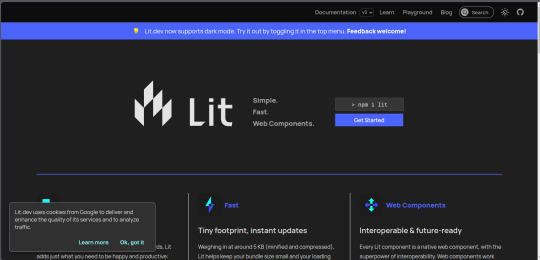
Conclusion
Choosing the right front-end framework or library can significantly impact your workflow and the quality of your projects. Whether you prefer the flexibility of React, the structure of Angular, or the simplicity of Svelte, there's a tool out there to suit your needs.
Final Tips for Selecting a Framework or Library
Project Requirements: Consider the specific needs of your project.
Community and Support: Look for frameworks with strong community support and documentation.
Learning Curve: Choose a tool that matches your current skill level and the time you have available to learn.
By staying informed about the latest tools and trends, you can ensure that your skills remain relevant and that you can deliver the best possible results in your projects. Happy coding!
Remember, the best tool is the one that helps you get the job done efficiently and effectively. So, dive into these frameworks and libraries, and take your front-end development skills to the next level!
Share Your Thoughts
I'm curious to know your thoughts on these front-end frameworks and libraries. Have you used any of them in your projects? Which one is your favorite, and why? Share your experiences and insights in the comments below.👇
2 notes
·
View notes
Text
Mastering Web Development: A Comprehensive Guide for Beginners
In the vast landscape of technology, web development stands as a crucial cornerstone. It encompasses the art and science of building websites, ranging from simple static pages to complex web applications. Whether you're aiming to pursue a career in software development or seeking to enhance your digital presence, understanding web development is essential.
In this comprehensive guide, we'll take you through the fundamental concepts and practical skills needed to master web development from scratch. Let's dive in!
1. Understanding HTML (Hypertext Markup Language)
HTML serves as the backbone of every web page, providing the structure and content. It uses tags to define different elements such as headings, paragraphs, images, and links. By mastering HTML, you'll be able to create well-structured and semantically meaningful web documents.
2. Exploring CSS (Cascading Style Sheets)
CSS is the language used to style HTML elements, enhancing their appearance and layout. With CSS, you can customize colors, fonts, spacing, and more, giving your website a polished and professional look. Understanding CSS selectors and properties is essential for effective styling.
3. Introduction to JavaScript
JavaScript is a versatile programming language that adds interactivity and dynamic behavior to web pages. From simple animations to complex web applications, JavaScript powers a wide range of functionalities. Learning JavaScript fundamentals such as variables, functions, and events is crucial for web development.
4. Building Responsive Websites
In today's mobile-centric world, it's essential to create websites that adapt seamlessly to various screen sizes and devices. Responsive web design achieves this by using fluid grids, flexible images, and media queries. Mastering responsive design principles ensures that your websites look great on desktops, tablets, and smartphones.
5. Introduction to Version Control with Git
Git is a powerful tool for tracking changes in your codebase and collaborating with other developers. By learning Git basics such as branching, merging, and committing, you can streamline your development workflow and effectively manage project versions.
6. Introduction to Front-End Frameworks
Front-end frameworks like Bootstrap, Foundation, and Materialise provide pre-designed components and stylesheets to expedite web development. By leveraging these frameworks, you can create responsive and visually appealing websites with less effort and code.
7. Introduction to Back-End Development
While front-end development focuses on the user interface, back-end development deals with server-side logic and database management. Learning back-end languages such as Node.js, Python, or PHP enables you to build dynamic web applications and handle user interactions efficiently.
8. Deploying Your Website
Once you've developed your website, it's time to make it accessible to the world. Deploying a website involves selecting a web hosting provider, uploading your files, and configuring domain settings. Understanding the deployment process ensures that your website goes live smoothly.
9. Conclusion and Next Steps
Congratulations on completing this comprehensive guide to mastering web development! By now, you've gained a solid understanding of HTML, CSS, JavaScript, version control, frameworks, and deployment. As you continue your journey in web development, remember to stay curious, practice regularly, and explore advanced topics to further refine your skills.
Resources for Further Learning:
Online tutorials and documentation
Interactive coding platforms
Community forums and discussion groups
Next Steps:
Explore advanced topics such as web performance optimization, server-side rendering, and progressive web apps.
Build real-world projects to apply your skills and showcase your portfolio.
Stay updated with the latest trends and technologies in web development through blogs, podcasts, and conferences.
With dedication and perseverance, you'll continue to evolve as a proficient web developer, creating innovative solutions and contributing to the ever-changing digital landscape . Happy coding!
4 notes
·
View notes
Text
youtube
Mastering CSS: Complete Guide to Styling Web Pages | Learn CSS for Web Development
In this comprehensive CSS tutorial, we delve into the world of Cascading Style Sheets, covering styling techniques, selectors, declarations, properties, and values in CSS. Whether you're a beginner or a seasoned professional, this video is designed to equip you with a thorough understanding of CSS. We explore advanced CSS concepts such as descendant combinators, pseudo-classes, pseudo-elements, @rules, shorthands, functions, and more. By the end of this video, you'll have the skills to style your HTML documents with precision and finesse. Watch now and take your web development skills to the next level!
#CSS#WebDevelopment#LearnCSS#FrontEndDevelopment#CSSStyling#CSSTutorial#CSSGuide#Coding#WebDesign#HTML#JavaScript#Youtube
3 notes
·
View notes
Text
Heading 1 (Biggest)
🗒️ Answer (Bigger)
Creating a custom Tumblr theme from scratch involves coding in HTML and CSS to design a unique layout for your Tumblr blog. Here's a step-by-step guide to help you get started:
Understand Tumblr Theme Basics: Familiarize yourself with Tumblr's documentation on creating a custom HTML theme (Source 1).
Learn HTML and CSS: If you're not already familiar with HTML and CSS, consider taking a course like "GA Dash" mentioned in this tutorial (Source 2).
Plan Your Design: Think about the look and feel you want for your Tumblr blog. Consider elements like colors, fonts, and layout.
Coding Your Theme: Start coding your theme using HTML for the structure and CSS for styling. Smashing Magazine provides a complete guide to Tumblr (Source 3) that can be helpful.
Test and Debug: Regularly test your theme on Tumblr to ensure it displays correctly.
Custom Features: If you want to add custom features or functionality to your theme, Tumblr's Build Themes (Source 4) may be a useful resource.
Seek Inspiration: Explore other Tumblr themes and blogs for inspiration. Creative Market's complete guide to Tumblr themes (Source 5) can give you more insights.
Share Your Progress: Consider sharing your coding progress and finished theme on platforms like Tumblr and Twitter, as you've done before.
Remember to continuously refine your skills and keep up with the latest web development trends to create appealing and functional Tumblr themes.
2 notes
·
View notes
Text
Becoming a Selenium Expert: Your Roadmap to Success
Selenium, the open-source web automation testing framework, has revolutionized the software testing industry by empowering testers to automate repetitive tasks and ensure the reliability of web applications. If you're looking to embark on a journey to master Selenium, you're in the right place. This comprehensive guide will take you through every step, from understanding the basics to mastering advanced topics, and even finding the best training resources to hone your skills.

Before you dive into the world of Selenium, it's crucial to establish a strong foundation in software testing and understand why test automation is essential.
Here's a step-by-step roadmap to kickstart your Selenium learning journey:
Understanding the Basics of Testing
Acquiring a solid understanding of software testing concepts is the foundation upon which your Selenium journey begins. It's crucial to grasp various testing types and recognize the significance of test automation in enhancing software quality. Software testing serves as the first line of defense against defects and errors, ensuring that the final product meets the desired quality standards. By understanding the basics of testing, you gain valuable insights into why Selenium automation is indispensable in today's software development landscape.
Learning the Fundamentals of Selenium
At the heart of Selenium automation lies Selenium WebDriver. To embark on your Selenium journey, you should start by comprehending its fundamentals. Selenium WebDriver acts as the bridge between your code and the web browser, enabling you to automate interactions with web elements. Fortunately, there is a wealth of online tutorials, documentation, and courses available to assist you in mastering Selenium. This powerful tool is your gateway to automating web testing, and a solid grasp of its fundamentals is essential for your success.
Choosing a Programming Language
Selenium is versatile in that it supports multiple programming languages, including Java, Python, C#, and more. When choosing a programming language, consider your comfort level and your eagerness to learn. Java, with its extensive community support and compatibility with Selenium, is a popular choice among practitioners. Your choice of programming language will be the medium through which you communicate with Selenium WebDriver, making it a pivotal decision in your Selenium journey.
Setting Up an Integrated Development Environment (IDE)
Efficiency is key when it comes to writing and executing Selenium scripts. To streamline your workflow, it's essential to install a suitable Integrated Development Environment (IDE) such as Eclipse or IntelliJ IDEA. These IDEs provide a conducive environment for coding, debugging, and running your Selenium scripts efficiently. Your IDE will become your trusted companion throughout your Selenium automation endeavors.
Mastering HTML and CSS
Selenium interacts directly with web elements, which underscores the importance of having a solid understanding of HTML and CSS. These foundational technologies govern the structure and style of web pages, and proficiency in them is crucial for locating and manipulating elements on web pages effectively. By mastering HTML and CSS, you equip yourself with the skills needed to navigate the web and interact seamlessly with the elements you encounter.
Practicing Locators
Web elements come in various shapes and sizes, and Selenium provides a range of locators to help you identify and interact with them effectively. Locators like XPath and CSS selectors are indispensable tools in your Selenium toolkit. Understanding how to use these locators to pinpoint web elements is a fundamental skill that will serve you well in your Selenium journey.
Hands-on Practice
Theory alone will only take you so far in mastering Selenium. To become proficient, you must put theory into practice. Initiate your Selenium journey by working on simple test scenarios and gradually progress to more complex ones. Real-world practice not only solidifies your understanding but also hones your problem-solving skills, a critical aspect of successful Selenium automation.
Exploring TestNG or JUnit
TestNG and JUnit are robust testing frameworks that seamlessly integrate with Selenium. They provide valuable features for organizing and managing your test cases effectively. Exploring these frameworks is a natural progression in your Selenium journey, as they enhance your ability to structure and execute tests systematically. TestNG and JUnit are powerful allies that will help you maintain control and organization in your automated testing endeavors.
Exploring Advanced Topics
Once you have established a solid grasp of the fundamentals, it's time to delve into more advanced aspects of Selenium. These advanced topics will not only deepen your understanding but also equip you with the skills needed to tackle complex web testing scenarios effectively.
Learning Automation Best Practices
In addition to mastering advanced topics, understanding and implementing automation best practices are crucial for becoming a proficient automation tester. These practices contribute to the efficiency, maintainability, and effectiveness of your automation projects.

Embarking on your Selenium learning journey is an exciting and rewarding endeavor that opens doors to a world of possibilities in the realm of software testing and quality assurance. As you navigate the path from understanding testing basics to mastering Selenium's advanced features, remember that practice, perseverance, and a passion for continuous learning are your allies.
In your pursuit of excellence, consider seeking quality Selenium training and guidance. ACTE Technologies stands as a beacon in this regard, offering comprehensive Selenium training programs. These programs provide structured curricula, hands-on experience, expert instructors, and certifications that can validate your Selenium expertise.
So, embrace your Selenium learning journey with enthusiasm, apply your newfound skills in real-world scenarios, and consider the invaluable resources and training opportunities ACTE Technologies offers to further enhance your Selenium proficiency. With dedication and the right resources, you're well on your way to becoming a web automation testing expert. Happy learning!
3 notes
·
View notes
Text
Prompt Examples for Learning Web Development

Coding is both an art and a science. It’s about creatively solving problems, bringing ideas to life, and constantly learning and adapting.
Because technology advances at such a rapid pace, it is essential to be fluent in a variety of languages, tools, and domains.
Sometimes it’s difficult to pick up the right resources from the ocean of tutorials, demos, and resources.
And on top of that, sometimes we have to learn and apply so fast due to tight deadlines of the projects. In this case, we need a friend who can help us learn and work faster and better. And thanks to AI by this, our learning becomes faster and more fun.
Today, we’ll look at how learning prompts that AI drives can change the way you learn web development.
How you can craft prompt engineering for web development, the difference between a generic prompt and a bit tweaked prompt can eventually change your desired results and make your learning journey more smooth and more enjoyable.
You can also use this knowledge to learn other fields more quickly and interactively.
Table of Contents
Learning Prompts
HTML Prompt Examples
CSS Prompt Examples
Debugging Prompts
Testing Prompts
Crafting Better Prompts
Further Reading and Resources
🎯Learning Prompts
Prompts are at the heart of AI-powered learning. Prompts are questions or commands that guide AI models like GPT-3 or GPT-4 to generate the desired responses. They act as a springboard for the AI to dive into the knowledge it’s been trained on and come up with relevant outputs.
You can use AI’s capabilities in a variety of scenarios in web development, including debugging, code generation, and even learning new web development concepts.
Now, we’ll go through some basic prompts and their outputs, as well as a little tweaking of the prompt commands to see how the output is becoming more result oriented, giving you a sense of how you may build your prompt commands for better results.
Prompt Commands for Learning HTML Basics
Learning the basics of web development involves understanding the structure and syntax of HTML, CSS, and JavaScript. Here are some prompt examples you can use:
Create a simple HTML structure with a header, main content section, and footer.
This prompt returns a simple HTML skeleton. But if you want a more detailed structure, you could modify the prompt to include specific HTML elements. For example:
Create a simple HTML structure with a header containing a navigation bar, a main content section with a paragraph and an image, and a footer with copyright information.
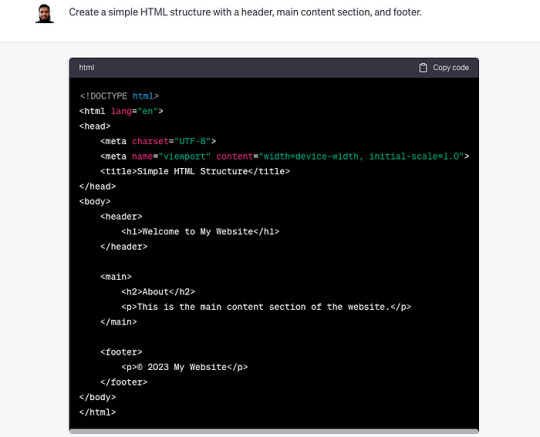
Curious to know more? Visit our blog for the complete post and dive deeper into Learning Web Development with AI Prompts.
3 notes
·
View notes
Text
CSS Tutorial: Everything You Need to Know

CSS or Cascading Style Sheets is a fundamental aspect of web development that controls the look and formatting of a website. If you're looking to learn CSS, then you're in the right place. This CSS tutorial will provide you with a basic understanding of CSS and teach you how to use it to style web pages.
In this tutorial, you will learn about the different types of CSS, such as inline, internal, and external CSS. You will also learn how to use selectors, properties, and values to style HTML elements. Additionally, you will learn about CSS box model, layout, and responsive design.
With the knowledge gained from this CSS tutorial, you can easily create a visually appealing website that is both user-friendly and functional. So what are you waiting for? Start learning CSS today and enhance your web development skills.
To delve more into CSS, visit https://www.tutorialandexample.com/css-tutorial for more detailed explanations and practical examples.
2 notes
·
View notes
Text
Looking to master the basics of HTML? WebTutor offers a comprehensive guide to help you navigate the world of HTML with ease. From understanding tags to building web pages, this tutorial is perfect for beginners. Start your journey to becoming an HTML pro today at WebTutor!
#Basic HTML tags explained#Introduction to HTML elements#HTML basics#HTML tutorial#Master HTML#HTML tags#Web development#Learn HTML#HTML for beginners#HTML guide#HTML syntax#Building web pages#Basic HTML elements#Learn HTML elements
1 note
·
View note
Text
Front end web developer skills you need to know
To become a successful front-end web developer, you’ll need a solid foundation in key skills. Mastering HTML & CSS is essential for creating the structure and style of websites.
JavaScript and ES6 add interactivity and modern functionality, while CSS & JS frameworks like Bootstrap and React streamline development.
Understanding GIT & GITHUB for version control and implementing responsive design ensures your projects work seamlessly across all devices.
In this article, we will review some of the key skills required for expert front web development.

Download Infographic
HTML & CSS
HTML (HyperText Markup Language) and CSS (Cascading Style Sheets) are the backbone of front-end web development. HTML structures the content of a web page, using elements like headings, paragraphs, links, and images.
CSS styles that content, controlling layout, colours, fonts, spacing, and responsiveness. Together, they allow developers to create visually engaging and well-structured websites.
Mastering HTML & CSS is crucial before moving on to more advanced topics like JavaScript or frameworks. You’ll need to understand concepts such as semantic HTML, CSS selectors, the box model, and media queries.
There are plenty of free and paid resources to help you learn. Great starting points include MDN Web Docs, W3Schools, and freeCodeCamp’s Responsive Web Design certification.
Platforms like Codecademy and Coursera also offer beginner-friendly courses. Practising by building small projects is one of the most effective ways to reinforce your learning.
JavaScript
JavaScript is a core technology of front-end web development, used alongside HTML and CSS to create dynamic, interactive websites. While HTML provides the structure and CSS handles styling, JavaScript enables user interaction by manipulating elements on the page in real-time.
It’s responsible for features such as form validation, image sliders, dropdown menus, modal windows, and dynamic content updates without reloading the page (using AJAX). JavaScript interacts with the Document Object Model (DOM), allowing developers to modify HTML and CSS based on user actions like clicks, scrolls, or keystrokes.
Modern front-end development often uses JavaScript libraries and frameworks such as React, Vue.js, or jQuery to streamline development and enhance functionality. Understanding JavaScript fundamentals is essential before diving into these tools.
There are excellent resources to learn JavaScript, whether you’re a beginner or looking to advance your skills. Top recommendations include JavaScript.info, MDN Web Docs, and freeCodeCamp. You can also find interactive tutorials on Codecademy, as well as comprehensive courses on platforms like Udemy and Coursera.
For in-depth understanding, the book Eloquent JavaScript is highly regarded in the developer community. Practising through small projects and coding challenges will solidify your knowledge.
ES6
ES6 (ECMAScript 2015) is a major update to the JavaScript language, introducing powerful new features that make coding more efficient and maintainable. It brought significant improvements to JavaScript syntax and functionality, including let and const for block-scoped variable declarations, arrow functions for cleaner, more concise function expressions, template literals for easier string formatting, and destructuring for simplifying data extraction from arrays and objects.
ES6 also introduced promises for better handling of asynchronous operations, modules for organising code into reusable components, and classes for a more structured, object-oriented approach to JavaScript development.
ES6 has become a standard in front-end web development, forming the backbone of modern frameworks like React, Vue.js, and Angular, where these features are heavily utilised to create fast, scalable, and maintainable web applications. It also improves code readability and reduces common bugs, making it an essential skill for front-end developers.
To learn ES6, great resources include MDN Web Docs, JavaScript.info, freeCodeCamp’s JavaScript course, and Codecademy’s interactive tutorials. The book Eloquent JavaScript also covers ES6 in depth, while platforms like Udemy and Coursera offer structured courses for more in-depth learning. Practising with real-world projects is the best way to master ES6.
CSS & JS Frameworks
CSS and JavaScript frameworks play a vital role in front-end web development by streamlining the coding process and reducing development time.
CSS frameworks like Bootstrap, Tailwind CSS, and Foundation provide pre-written CSS classes and components for creating responsive layouts, navigation menus, buttons, and more. They help ensure consistent design and save developers from writing repetitive code.
JavaScript frameworks such as React, Vue.js, and Angular offer structured approaches to building interactive user interfaces and managing complex application states. These frameworks simplify DOM manipulation, improve performance, and enable the creation of reusable components.
By using these frameworks, developers can build modern, responsive, and scalable web applications more efficiently.
To learn CSS frameworks, explore the official documentation for Bootstrap or Tailwind CSS, as well as tutorials on freeCodeCamp and W3Schools. For JS frameworks, the React and Vue.js official docs, MDN Web Docs, Codecademy, and Scrimba offer excellent learning paths.
GIT & GITHUB
GIT and GitHub are essential tools for front-end web developers, enabling efficient version control and collaboration. GIT is a distributed version control system that tracks code changes, allowing developers to manage project history, revert to earlier versions, and work on multiple features simultaneously using branches.
GitHub is a cloud-based platform that hosts GIT repositories, making it easy for developers to collaborate, share code, and contribute to open-source projects. It also offers features like pull requests, code reviews, and issue tracking to streamline development workflows.
In front-end web development, GIT and GitHub are used to manage code for websites and applications, ensuring version control and seamless collaboration. They also make it easy to showcase projects in a professional portfolio.
To learn GIT and GitHub, consider GitHub Learning Lab, freeCodeCamp, Codecademy, and MDN Web Docs. Platforms like GitHub Docs and GitKraken also provide excellent guides and tutorials for beginners.
Responsive Design
Responsive design is a crucial aspect of front-end web development, ensuring that websites look and function well across a wide range of devices, from mobile phones to large desktop screens.
It focuses on creating flexible layouts, images, and components that automatically adjust to different screen sizes and orientations. This approach enhances user experience, boosts SEO, and reduces bounce rates by delivering a consistent browsing experience, regardless of the device.
Responsive design relies on key techniques like media queries, flexbox, and CSS grid to control the layout and structure of a website. Fluid grids and responsive images ensure content scales appropriately, while mobile-first design prioritises smaller screens before scaling up to larger devices.
Many front-end frameworks, like Bootstrap and Tailwind CSS, include built-in responsive design features, making it easier to create flexible layouts.
In modern front-end development, responsive design is essential, as mobile traffic continues to grow. It’s a core requirement for building professional websites and web applications.
To learn responsive design, consider resources like MDN Web Docs, W3Schools, and freeCodeCamp’s Responsive Web Design certification.
Books like Responsive Web Design with HTML5 and CSS by Ben Frain and platforms like Codecademy also offer comprehensive tutorials.
Building small projects and experimenting with media queries is a practical way to master this vital skill, ensuring your web pages deliver a seamless experience across all devices.
Conclusion
Mastering front-end web development skills like HTML & CSS, JavaScript, ES6, CSS & JS frameworks, GIT & GitHub, and responsive design is essential for building modern, high-performing websites.
These skills form the foundation of interactive, responsive, and visually appealing web pages. By leveraging powerful frameworks and adopting best practices, you can streamline your workflow and create exceptional user experiences.
With countless online resources available, from MDN Web Docs to freeCodeCamp, there’s never been a better time to start your front-end development journey. Keep practising, stay curious, and continue expanding your skill set to become a proficient developer.
Article first published: https://dcpweb.co.uk/blog/front-end-web-developer-skills-you-need-to-know
0 notes
Text
Understanding ReactJS – A Beginner-Friendly Guide

Introduction
ReactJS is widely used in various industries, including web development company in Bangalore, which leverage its capabilities to build dynamic and scalable applications.
Imagine a world where building a website is like assembling LEGO blocks—each block representing a specific function. This is exactly what ReactJS does! ReactJS is a powerful JavaScript library developed by Facebook that helps developers create interactive user interfaces in a structured, reusable, and efficient way. Since its release in 2013, it has become a game-changer in web development, powering applications like Facebook, Instagram, and Airbnb.
ReactJS has revolutionized front-end development by making it easier to build large-scale applications with reusable components and a seamless user experience. In this guide, we will break down ReactJS into simple, digestible concepts, making it easy for beginners to grasp and use effectively.
What is ReactJS?
ReactJS is an open-source JavaScript library designed to create fast and dynamic web applications. Unlike traditional HTML and JavaScript, where each change refreshes the entire webpage, React uses a smart feature called the Virtual DOM to update only the necessary parts. This significantly boosts performance and enhances user experience.
Why Choose ReactJS?
Component-Based Structure: Applications are built using reusable components, making development organized and efficient.
Lightning-Fast Performance: The virtual DOM optimizes updates, improving speed.
Strong Community & Support: With a vast developer community, solutions and tutorials are readily available.
SEO-Friendly: Unlike other JavaScript-heavy frameworks, React supports server-side rendering, improving search engine rankings.
Scalability: From small projects to large enterprise applications, React scales seamlessly.
Cross-Platform Development: React Native, a React-based framework, allows developers to build mobile applications using the same concepts.
Core Concepts of ReactJS
1. Components – The Building Blocks
Think of React components as small, reusable pieces of a website, just like individual LEGO pieces. A component can be a button, a form, or an entire page!
There are two types of components:
Functional Components – Simple, stateless components that return UI elements.
Class Components – More powerful components that can manage their own state and lifecycle events.
Components help in modular development, making it easier to maintain and scale applications.
2. JSX (JavaScript XML) – Writing HTML in JavaScript
React uses JSX, a special syntax that looks like HTML but works inside JavaScript. JSX makes UI code easier to read and write, reducing complexity and improving development speed.
3. Props – Passing Data Between Components
Props (short for properties) allow components to communicate with each other by passing data. They help in making components dynamic and reusable.
4. State – Managing Dynamic Data
State is used to store and manage data that can change over time. Unlike props, which are read-only, state can be updated dynamically. This makes applications more interactive and responsive.
5. Virtual DOM – The Secret Behind React’s Speed
Traditional web applications update the entire webpage when a change occurs. React, however, creates a Virtual DOM, a lightweight copy of the actual DOM. Instead of reloading everything, it updates only the changed elements, making applications incredibly fast.
Getting Started with ReactJS
Setting up a React project is simple. Follow these steps:
Install Node.js and npm: React requires Node.js, which comes with npm (Node Package Manager).
Create a React App: Open the terminal and run npx create-react-app my-app.
Navigate to the project folder: Use cd my-app.
Start the development server: Run npm start. Your app will open in the browser at http://localhost:3000/.
This setup creates a structured environment to build React applications efficiently.
Advanced React Features
1. React Hooks – Making Functional Components More Powerful
Hooks allow functional components to manage state and side effects. The useState hook is one of the most commonly used, replacing class components in many cases.
2. React Router – Handling Multiple Pages
React applications often need navigation between different pages. React Router enables this functionality without requiring full-page reloads, ensuring smooth transitions between components.
3. Redux – Managing Complex Application State
As applications grow, managing state becomes challenging. Redux is a popular library that helps manage state in a predictable and structured way, making applications easier to debug and maintain.
4. Context API – An Alternative to Redux
For applications that do not require a complex state management system, React provides the Context API. It allows data to be passed globally without the need for prop drilling, improving code efficiency.
5. Server-Side Rendering (SSR) – Improving Performance and SEO
React supports SSR, which allows content to be rendered on the server before being sent to the client. This enhances page speed, improves SEO, and ensures better user engagement.
Best Practices for React Development
Keep Components Small and Focused: Each component should have a single responsibility.
Use Functional Components and Hooks: They make code simpler and more readable.
Optimize Performance: Use techniques like lazy loading, memoization, and avoiding unnecessary re-renders.
Follow a Consistent Folder Structure: Organizing components, assets, and utilities properly improves maintainability.
Use Error Boundaries: They help in handling errors gracefully without breaking the entire application.
Write Clean and Reusable Code: Reusing components and avoiding redundant code improves efficiency.
Future of ReactJS
React continues to evolve with new features and improvements. Some trends shaping its future include:
Concurrent Mode: Improving performance by allowing multiple tasks to run simultaneously.
React Server Components: Enhancing server-side capabilities.
Better Developer Experience: With updates in developer tools and debugging features.
With strong community support and continuous updates, ReactJS remains a top choice for front-end development.
Conclusion
ReactJS is a powerful tool that makes web development easier, faster, and more efficient. With its component-based architecture, virtual DOM, and advanced features like hooks and routing, it’s no wonder that companies worldwide rely on it.
By learning React, you unlock the potential to create stunning, high-performance web applications. Whether you’re a beginner or an experienced developer, mastering ReactJS will open doors to countless opportunities in the tech world.
With its vast ecosystem, seamless integrations, and continuous improvements, ReactJS remains at the forefront of web development. If you're planning to dive into front-end development, ReactJS is the perfect technology to master.
Keywords: ReactJS, JavaScript, Web Development, UI Components, Virtual DOM, Front-End Development, React Hooks, Redux, Server-Side Rendering, React Router, Context API, Web Development Company in Bangalore
#ReactJS#WebDevelopment#JavaScript#FrontendDevelopment#ReactComponents#VirtualDOM#ReactHooks#WebDevelopmentCompany#BangaloreTech#SEO#UIUX#SoftwareDevelopment#Programming#Coding#ReactNative#TechTrends
0 notes
Text

Top 10 Angular Features You Must Know
To build web applications with Angular, you need to use the Angular framework for JavaScript. Because it is one of the frameworks that most people use, many big companies rely on it. Angular is a good framework because it has so many features that help when building websites. But every programmer should know about a few angular functions that aren't as well-known. Using this list of angular capabilities will help you write code that is easier to change and test.
In addition to this, it assists developers in better improving the functionality of the software. The reason for this is its trustworthiness in the development of online apps that run in browsers. In addition to this, it is the most effective medium for developing Single Page Applications, also known as SPAs. Because it has so many different capabilities, this free and open-source framework is an excellent choice for creating dynamic websites. As a result, in this post, we will investigate the core of Angular's popularity: its best features.
What is Angular?
Angular is a Google-supported open-source framework and platform for developing TypeScript-based Single Page Apps. Originally, Angular was meant to be the successor to the widely used AngularJS framework. Despite this, design decisions led Google to offer it as a standalone product; this includes the absence of backward compatibility and the straightforward upgrade route from AngularJS to Angular 2.
The MIT license lets anyone use the Angular framework, which is open-source software. It's easy to see why Angular is so popular among developers; the framework offers a consistent foundation with several obvious benefits. Users can build scalable, robust apps with its help.
Essential Features of Angular
1. Maximum Speed and Efficiency
By translating templates directly into code, Angular revolutionizes the contemporary JavaScript virtual machine. So, the hand-written code you created can take advantage of a useful framework. The best feature of Angular is that it allows you to render the code into HTML and CSS, giving you the ability to view the application for the first time on any other platform, like Node.js,.Net, PHP, and so on. The amount of time it takes for apps built using Angular to load is noticeably less than that of any other front-end framework currently available.
2. Data Binding
By using a technique called "data binding," visitors to a website are able to control certain aspects of the page directly within their browser. Developers don't need any complex scripting or coding for Angular; just easily modifiable HTMLPages with interactive elements like calculators, tutorials, forums, and games that employ data binding. When a website has a lot of data, this also allows for a better incremental display. Angular makes use of two-way binding. Developers can do easy modifications to the associated UI elements reflected in the model state. With this capability, the framework can link the DOM to the model data via the controller.
3. Declarative UI
A declarative user interface is one of AngularJS's main characteristics. When working with Angular, you can forego utilizing JavaScript to define the user interface of your web app and instead rely on HTML, which is simpler. When used with Angular, HTML's ability to import the declarative and intuitive characteristics of UI components proves to be a boon. Having these characteristics eliminates the need to manually start up program flows. You can instead only explain the flow of information and how the pages are laid out. The components are also managed according to the layout of Angular's declarative UI. This helps save a lot of time and energy in front-end development.
4. Standalone Component
This is one of the many cutting-edge capabilities that are currently provided by Angular in its current iteration. With the assistance of the standalone component, you can build a module that can be reused and then inserted into any Angular app. It is one of the most recent angular additions to the collection. This is an excellent new feature in Angular that was added for building modular apps. A standalone component does not need to have a module added to it to function, but the module is still accessible for use if it is desired. This is the most important advantage that comes with using a standalone module.
5. Universal Access to Angular Apps
In addition to allowing the development of mind-blowing applications, Angular's magical front-end platform also allows the creation of high-end animations to improve the user experience. The application programming interface (API) for Angular is so easy to use that you can easily create a complex animation and choreography with very little code. Furthermore, using modern unit testing frameworks, you can fix your faulty code whenever you choose.
More than eleven unit testing modules are already included in Angular, guaranteeing bug-free programming. One of Angular's groundbreaking characteristics is the ability to create accessible applications. The accessible applications are used by all users, including those with disabilities.
6. MVC Architecture
Model-View-Controller is the abbreviation for the architectural pattern. The Model controls the application's data, whereas the View is responsible for displaying that data. At the same time, the controller's role is to bridge the gap between the view and model levels. The MVC architecture allows you to divide your program into its constituent parts and then connect them with code. On the other hand, Angular only requires developers to divide the program into MVC, and the framework takes care of the rest. And it reduces the amount of time spent programming by a great deal.
7. CDK and Angular Material
With each new release, Angular, a leading front-end language, enhances its Component Development Kit (CDK). The most recent version of the Angular CDK has support for virtual scrolling and automatic refreshes. It's useful for both dynamically loading and unloading the DOM, allowing you to quickly compile a huge amount of high-performing data in a single location. You can add both the Drag-and-Drop Model and the Scrolling Model to the program. This DragDropModule's spotlight features include list-level sorting, free dragging, previews, and placeholders. It also facilitates moving objects between lists and rearranging their order within a list.
8. Angular CLI
With the Command Line Interface (CLI) feature of Angular and Angular.js, developers can send the user's instructions as text. Angular CLI will also automate some tasks by following the instructions given to it by the developers. Angular developers can use these basic commands to add or remove parts of a webpage. Installing dependencies and putting together many features will take less time for Angular developers if they choose to do so.
9. The Abilities of Ivy Renderer
With the help of a renderer, it is easier to convert code written in TypeScript and HTML to the more common syntax of JavaScript. This helps the browser understand it better. If you want to ensure that everything is displaying properly in the browser, you need to convert the component definitions and template files you employ into a language the browser can read. Ivy Renderer can reduce the size of a web application and make it load faster by getting rid of unused code. At the end of the day, this function makes both the Angular framework and the bundle smaller.
10. Plenty of Resources and Instructions
One of the primary reasons that Google recommends using the Angular framework is because of its high level of dependability. The documentation and tools that Google has supplied have been of enormous assistance to the Angular community, which has reaped many benefits as a result. The Angular community makes all of these tools available to its developers, ensuring that they are never truly alone in their work. The discussion forums and the files both provide all of the information that you require.
Wrapping Up
You are familiar with the components that make up Angular. You have to be aware of the steep learning curve associated with Angular if you want to be an entrepreneur. Front-end Developers are expected to have a solid grasp on many aspects, including libraries, templates, directives, and modules. For this reason, you should look for an Angular.js development company that has a lot of work experience in addition to plenty of hands-on knowledge.
0 notes
Text
Are you ready to master CSS syntax and create stunning, responsive webpages? Whether you’re just starting with web development or looking to enhance your styling skills, this tutorial is perfect for you! In this lesson, we'll break down the syntax of CSS in HTML, helping you understand how to apply styles to HTML elements with ease.
#HTML#CSS#WebDevelopment#FrontEndDevelopment#TechBooks#WebDesign#HTMLandCSS#WebDevelopmentCourse#CSSDevelopment#HTMLTutorial#CSSTutorial#WebDesignTutorial#TechEducation#ResponsiveDesign#WebDevelopmentTips#CSSForBeginners#HTMLForBeginners#FrontendWebDevelopment#TechLearning#WebsiteDesign#WebDevelopmentSkills#HTML5#CSS3#WebDesignPrinciples#WebDevelopmentResources#TechCommunity
0 notes
Text
From CSS to JSON in Seconds: A Hands-on Tutorial with JS2TS tool
Introduction
It is very tedious to manage data and styles when you are building websites and applications. CSS and JSON are both strong tools but for different purposes. Some use style pages using CSS and others use data storage and transmission using JSON. It can be convenient to convert CSS to JSON format in order to manage and work with styles in your projects, especially when working with large-scale applications.
The JS2TS tool comes in at that point. This is a very useful tool that will allow you to quickly and easily convert CSS into JSON format and therefore it’s a good choice for developers who want to optimize their workflow. Meanwhile, in this blog, we’ll see in detail how the JS2TS tool aids with the CSS to JSON conversion process and also why it is important for the current web development.
What is the JS2TS Tool?
The JS2TS tool is a tool that aids in turning data from one format into another quickly and proficiently. It’s known for converting JSON to TypeScript but also can convert CSS to JSON. With CSS styles, the tool automatically generates JSON in order to save developers time and efforts.
It’s especially useful when you need to deal with big dynamic stylesheets or working with 'front-end frameworks’ that have JSON-based objects and configuration. The JS2TS tool automates this process, allowing you to have less chance of errors, make your code more consistent and more easily manage your styles.
About CSS
Cascading Style Sheets (CSS) is a stylesheet language used for describing the presentation of documents written in HTML or XML. This enables you to set the layout, colors, fonts, and the overall design of a website. CSS is crucial in the act of making web pages look visually appealing as well as be user-friendly.
It simply allows you to apply rules to HTML elements, making it easier for developers to create attractive looks without touching the content. But as the complexities of websites increase, managing CSS files gets difficult, very much so if you have not fewer but more than one stylesheet to manage and maintain.
About JSON
JSON (JavaScript Object Notation) is a lightweight data format that is used to exchange data between a server and a client. It is organized information with key values, easy for humans as well as machines to both read and understand.
The reason why JSON is so popular in web development is that it’s easy to work with and easily parseable by most programming languages, including JavaScript. Configuration settings, user preferences, or data from an API are very often stored as JSON. Storing style-related data in a structured and accessible way can be achieved by converting CSS into JSON.
Importance of Converting CSS to JSON
Converting the CSS into JSON will be greatly appreciated for a big project or when we’re dealing with dynamic style. When you store the styles in JSON format, you can easily update, modify, or retrieve the style information in an easy way without changing the CSS files directly. With JSON, you are better able to organize your styles and this is very important when working on complex designs.
It also makes the integration with JavaScript frameworks or libraries easier, as one might have to dynamically change the style depending on user input or application state. Furthermore, JSON is more flexible, flexible to manipulation or extend to support more advanced features like theming or responsive design.
How is the JS2TS tool beneficial for converting CSS to JSON?
Converting CSS to JSON is an expensive and time-consuming duty for developers; the JS2TS tool automates that. With JS2TS tool, you do not have to write out the necessary JSON code for your styles manually; you can simply convert your CSS to it instantly. It makes everything a part of your application, allowing you to see the structure that is being translated even and then translated into JSON format so that you can have your styles wherever your application is located.
By doing this, it reduces any chance of human error, increases consistency throughout your project, and simplifies the step. Converting your CSS into JSON also allows you to handle your styles better, and the resulting code is cleaner and easier to maintain.
Why is CSS to JSON conversion better for scalable projects’s?
Managing CSS for large scale projects or applications with many components is overwhelming. Also, styles break as the size of your project increases; in some cases, you may even want to dynamically adjust styles or combine them with other code in your project. It is easier to handle these changes when you convert CSS to JSON.
Also Read: How to Convert JSON to TypeScript Made Easy?
Since JSON is structured and flexible, JSON allows you to update, modify, or extend style easier. In particular, this is convenient when you have many stylesheets, user preferences, or themes you may have to change dynamically. With JSON to handle the styles, your code will become very scalable, very organized, and super easy to maintain to keep your code as you expand your project.
How does the JS2TS tool speed up JSON adoption?
The JS2TS tool enables you to speed up the JSON adoption into your projects with a JSON conversion. Since the tool produces accurate JSON from your CSS code, you can begin using JSON to manage styles right away without having to manually convert all of the rules.
That makes it a more easy way for developers to comfortably adopt JSON as part of their workflow while not having to waste time working their styles into the correct formatting or fix inconsistencies. The JS2TS tool will help you switch to JSON for your styles without much hassle and enjoy the flexibility and scalability of JSON.
Conclusion
To sum it up, converting CSS into JSON will simplify your projects to a great extent, both organizationally and in terms of flexibility and scalability. Using the JS2TS tool, developers can easily and quickly convert CSS to JSON so that time is saved and mistakes are less likely to be made.
Also Read: Convert Object to JSON in a Snap
As you should be while developing a small site or large-scale web application, converting CSS to JSON is a good solution to keep code clean and maintainable. The JS2TS tool enables you to reduce the development time, use JSON more efficiently and bring you modern-style features and scalable, maintainable projects.
0 notes